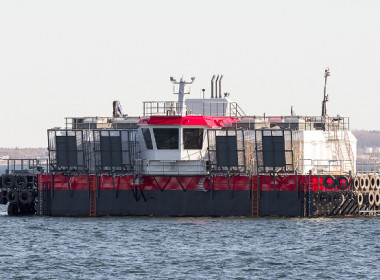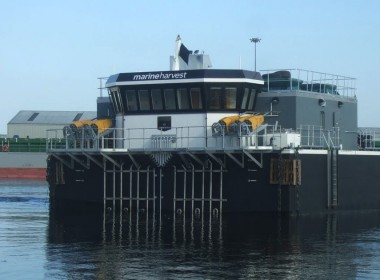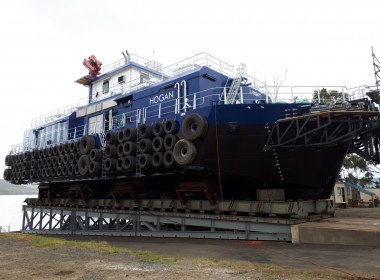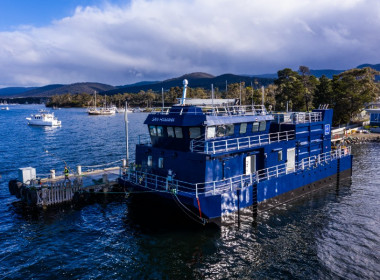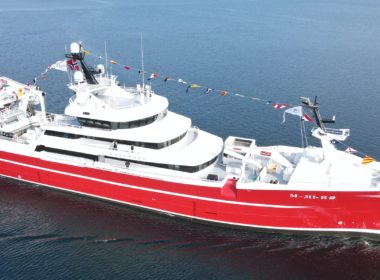AWARDS 2023 | Best Feed Barge – 485-tonne feed barge – GroAqua

Best Feed Barge – 485-tonne feed barge – GroAqua
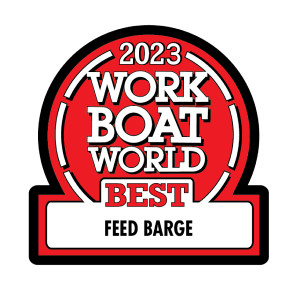
Fish farm support vessels are, of necessity, becoming larger as they have to operate ever further offshore.
Faroe Islands based designer/builder GroAqua has considerable experience with such vessels. This 485-tonne feed barge illustrates its talents perfectly.
Built for a leading Icelandic salmon farmer, this innovative fish-feeding barge will operate in very exposed conditions off Northern Iceland. It has been designed and built especially for safe activity in icy Arctic conditions.
“Designed for the harsh environment in the Westfjords in Iceland where the temperature can go down to minus 20 degrees, the barge can withstand a significant wave height of up to 5.5 metres even with an additional 70 tonnes of ice on the deck,” Suni Justinussen, GroAqua’s Chief Executive Officer, told Baird Maritime. “The hull has double sides, making it more robust and safer to operate, while the bow in the front allows it to ride the waves for greater stability.”
Justinussen also outlined the barge’s other features, such as its ability to operate automatically and be controlled remotely from shore, a hybrid power supply that allows generators to run only two to four hours out of a whole day (thereby maximising fuel efficiency and reducing emissions), placement of the selector valves below deck to guarantee crew safety and ease of maintenance, a separate built-in feeding system for cleaner fish, and built-in heaters to reduce ice buildup on the deck and the railings during winter.
“The biggest challenge we faced was related to the short timeframe we had for construction. Fortunately, despite the limited time available, we successfully completed the project and delivered it two weeks ahead of schedule.”
Justinussen added that constructing a barge suitable for the harsh Icelandic winter conditions, which also called for a de-icing system on the deck and in the railings, was an interesting exercise. Additionally, maintaining stability with 70 tonnes of ice on the deck required extensive calculations and careful consideration.
“Every barge we build is a process we go through with the buyer. It is normally a beneficial process where we learn a lot about the needs of each fish farmer, and our work on this barge was no exception. With this process, we learned a lot about the requirements that fish farmers in Iceland have for their feeding barges.”
Justinussen said every barge built by GroAqua is constructed according to the highest standard. “Some trends in salmon farming have to do with fish farmers trying to push the limits by going further out in the fjords and to more exposed sites,” he told Baird Maritime. “With our expertise in managing the challenging conditions in the Faroe Islands, these trends greatly impact our direction of focus because we want to keep being frontrunners in building feed barges for the ones going further offshore to farm salmon.”
Justinussen commented on 2023 being a satisfactory year for GroAqua despite the fact that companies working in the salmon industry were affected by political tax decisions made in Norway and the Faroe Islands.
“We are optimistic about the future, and our plan to grow the company is still on track. The merger with Havida in Norway in January has been very well-received by Norwegian fish farmers, and this has already resulted in a boost in sales in the country.”
In Justinussen’s view, the aquaculture industry needs to grow as the demand for seafood will increase in the coming years, and standard fisheries cannot seem to keep up with the demand.
“We will see many innovative projects in an attempt to change the way that we farm salmon today. In farming regions like the Faroes, Iceland, and partly the UK, we will see salmon farmers try operating in more exposed areas to increase production. We are also seeing investment being made in land-based farming, particularly in Iceland where operators will invest heavily because of cheaper energy and an abundance of water.”
Justinussen added that these days, the attitude within the North Atlantic feeding barge industry seems to be, “the bigger the better”.
“We see bigger wellboats being built,” he told Baird Maritime. “We also see bigger service vessels, bigger cages in the sea, and bigger feed barges. All this has the aim of enabling farmers to go further offshore and to increase production. We also see investments being made on land to be able to breed bigger smolt in an attempt to shorten the production period in the sea, and therefore minimise the environmental risks. For suppliers like ourselves, it is important to follow the salmon industry and the expectations that come with it.”
For a list of the 2023 “Best Of” award winners, please click here.




